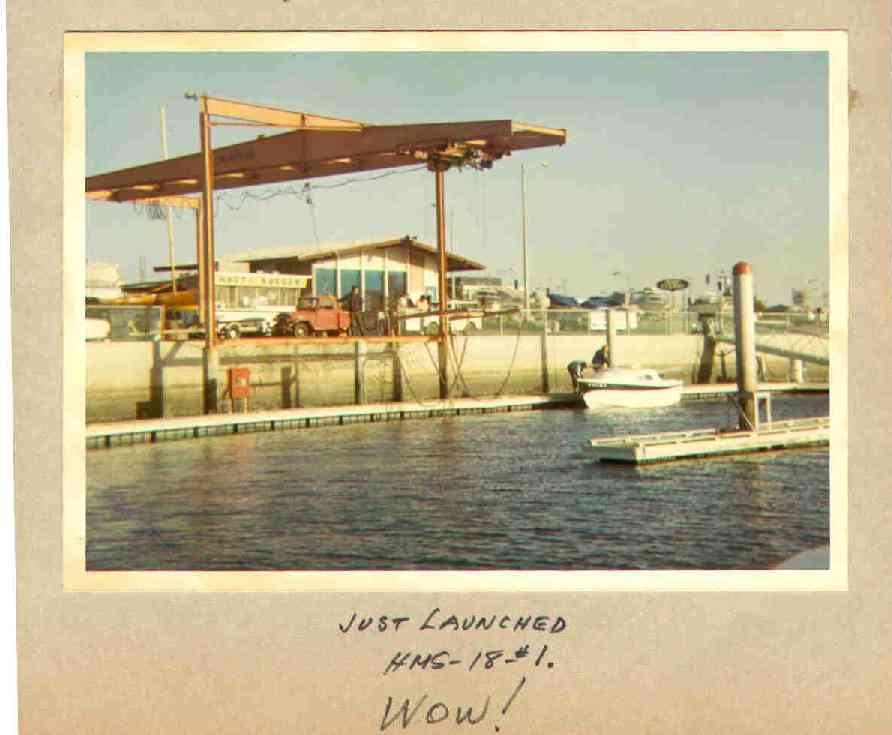
By Judith Franklin Blumhorst, DC

OK, here's some history, as told to me by Jerry Barrilleaux.
HMS Marine, owned by Herb Stewart, bought the US rights to produce the West Wight Potter from Stanley Smith. Herb started building the Potter 14's in the early 60'sor late 50's. In 1970 or 71, he designed and started building the HMS18. In 1975 the price of resin went through the roof (remember the oil embargo?), and they stopped building the HMS18's. The demand for them wasn't as strong as the P14's and there wasn't as much profit in them. The last one built that we know of was hull #71.
Also in 1975, HMS introduced some design improvements by Herb Stewart for the P14's (different daggar case, higher transom, marconi sailplan rather than gunter rig, plus and a few other things). The improved P14 design was called the Potter 14 Mk2. It was enormously successful. But the economy sucked and the price of resin was still plaguing the boat industry. More than half the boat builders went under between 1972 and 1980.
In 1978, Herb sold HMS Marine to Joe Edwards. Joe had never built a boat in his life and barely knew how to sail. But he was a good businessman. That's when the Potter 14 Mk2 became a Potter 15 Mk2. All Joe did was add the motor bracket on to the previously measured length. The boats magically got 1 foot longer. The early Joe Edwards boats were a little rough in terms of the "fit and finish"..
Joe didn't build any big Potters until 1981 or 1982. By then, the economy was in better shape, and the cost of resin was more attractive. He renamed the HMS18 a Potter 19 (made it a foot longer through the magic of measuring the motor bracket), to capitalize on the success of the Potter 15 MK2. By then Herb Stewart was dead. Joe started the numbers at 200. There were no big Potters built between 1975 and 1981, nor any hull numbers between 71 (that we know of) and #199.
Joe tried all kinds of different ideas. (He introduced the short rig, the lighter mast, etc), he also kept reducing the features on the base boat to keep the price down and keep the company alive at a time when 4 out of 5 boatbuilders went bankrupt. For example, the backstay because an "option" instead of standard equipment. The quality of fit and finish on Joe's P19's wasn't as good as the HMS 18's, but the hulls and decks were strong, with newer and stronger resins and glasscloths than the orginal 18's. Joe switched to balsa core (ligher, stronger, more rot resistant) rather than the plywood core found on the 18's. Joe Edwards used ungalvanized and a different (less expensive) shape on the keels for both the 15's and 19's.
Joe kept the company alive until 1992 when he sold the rights to the Potter design and name to Larry Holt (?), who renamed the company "International Marine". That's when Darrow Bishop worked at IM. IM slowly and steadily made numerous improvements in build quality, as well as returning to some of the original designed features. For example, the original HMS18s had galvanized keels with a certain shape. They started using only top quality hardware from Harken, Schaeffer, Gauhaer, etc. IM reintroduced the original shape keel (they literally copied Jerry's keel) and hot-dip galvanizing in 1996-7. In 1997, somewhere around hull #950 the keelcap with the neoprene gasket and the four-lockdown "dogs" were introduced. In summer of 1997, a new (computer generated from CAD drawings) hull mold was made to replace the old one. In 1997, the Baja trailer for the P19 was introduced.
About a year ago, in spring of 2001, Dave Dressler bought IM. In the year since Dave bought the company, he has introduced several changes that owners have been suggesting for years, like moving the batteries in the P19's to the v-bertg, better selection of option packages, re-introducing an optional one piece rudder for the P19, optional coring for the P15 deck, etc.
In 2001, a new deck mold was put in service, to replace the old one which was pretty worn out and producing imperfections in the gelcoat finish (Boats were sticking to the mold, there were marks in the mold which produced high spots and low spots that looked too much like cracks in the gelcoat in various places in the cockpit and one deck). The new non-skid pattern is beautiful. The deck mold was computer generated from CAD drawings, which corrected a couple of minor asymmetries in the deck mold (for example, now the companionway hatch is symmetric from side to side, so you can make symmetric replacement hatch boards).
For local color and more details on the evolution of the P14-15, ask Jerry Barrilleaux. He knew Herb Stewart and Joe Edwards. Also ask Harry Gordon -- he's the US expert on the Gunter rig P14's and the Potter-14s in the UK.
Fair winds, Judy Blumhorst,DC, 1985 WWP19 #266, Redwing, SF Bay, CA